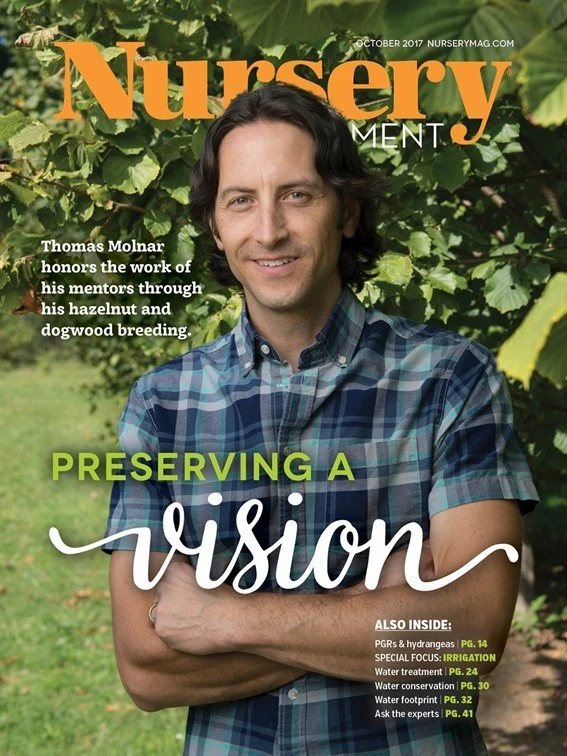
For generations, professional growers have used peat moss as a soilless medium base because of its high structural stability, high capacity for water and air retention, adjustable pH and nutrient status, and lack of insect pests. Lambert Peat Moss, based in Québec, has offered numerous lines of professional growing mixes and retail potting mixes as well as select types of premium peat moss since 1928. Detractors say peat is unsustainable and that the companies harvesting it are depleting the resource. New products like rice hulls and coconut coir have entered the horticulture industry, positioning themselves as sustainable alternatives. Otto Kaufmann, national account manager for Lambert Peat Moss answered our questions.
1 | What’s the current peat situation in Canada?
Everyone claims we’re depleting the bogs when in fact peat is replenishing itself 70 times faster than we are harvesting it in Canada. In Europe, the reason they’ve depleted all their bogs is they were using their peat for fuel.
Lambert has been harvesting since 1928. The bog with the lowest amount of peat is only down three feet. We only harvest 1.5 inches for the season, all during a 90-day window. We have enough peat to last another 500 years if we keep going at the same rate.
I had some students from North Carolina State University with me recently, showing them how we reseed the bogs with sphagnum. It’s growing back again. Because the peat bogs are like a bowl, the edges are always the first part to be depleted. We convert those to blueberry and cranberry fields.
2 | How can a grower decide which type of peat is right for them?
It depends on the application and how it will be used. We have fine grind for plug media. Then we have regular growing medias for other pots, and other blends as well. We blend peat according to need.
We generalize it as a plug media, then we have a growing on media, we have a media for rooting, which means it has more airspace, so the cutting does not sit in water. By doing that, we add other aggregates like perlite, vermiculite or even coconut coir.
Peats are also differentiated by color. The color of the peat is an indicator of the age of the peat and its degree of decomposition in the bog. In the U.S., growers like a peat that is more blonde. The ways the bogs are produced, the blonde peat is the upper surface of the bog. As you progress and harvest further down, it gets darker in color because the peat has started to decompose. Brown peat is older peat, it does not break down as easily.
3 | What should growers look for in their peat?
When you have elaborate machines that get plugged up with sticks or twigs it poses a problem. So we make sure our screening and cleaning process is done quite well. Because our peat is clean, we’re able to provide growing medias for nurseries that provide seedlings in small trays, including Ellepots, with little or no problem.
An Ellepot is like a sausage that is produced for plug producers and growers. The membrane is made of paper. When you provide peat with a lot of sticks in it, it tends to puncture that paper covering and in doing so it ruins the process of trying to grow your seedlings. When you are doing seedlings in a tray that has 200 cavities or more, if you have
We also provide a peat that is almost free of dust – the small particles of peat that tends to plug up cells. When someone waters, you want to have as little dust as possible in the plug so the water percolates better. When you have peat that is inferior, the dust plugs it up and drainage becomes a problem.
4 | How can a grower store peat safely?
If peat is in a compressed bale, the elements are not affected whatsoever. If you’re using a wetting agent, there is a time span. The wetting agent allows the peat to hydrate and absorb water more readily. When peat is dry and you apply water to it, the water runs off. The peat doesn’t soak it up. The wetting agent is like a soap, an adjuvant. What it does is allow the peat to soak up moisture. That’s why all of our medias are done to order. They are always fresh. We don’t just make big mixes and set them aside.
In the
Get curated news on YOUR industry.
Enter your email to receive our newsletters.
Explore the October 2017 Issue
Check out more from this issue and find your next story to read.
Latest from Nursery Management
- [WATCH] Winter is coming...but spring will bring disease
- Sam Hoadley talks about Mt. Cuba Center's latest evaluation of Solidago sp. for the Mid-Atlantic region
- Prices & Market Segments
- Countdown to shutdown
- All in the family
- From growing plants to growing people
- Weed Control Report
- Advocacy in action






